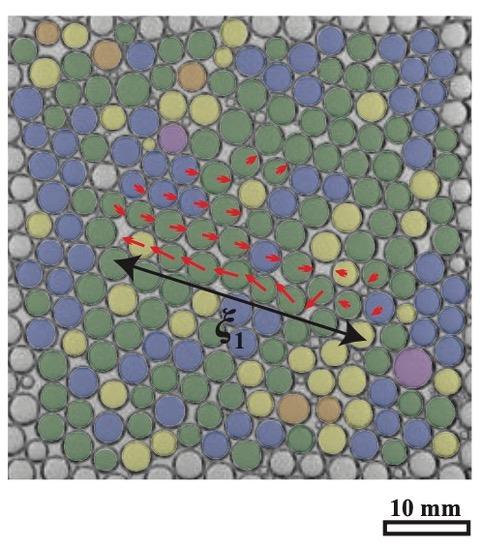Shuffling bubbles reveal how liquid foams evolve

A rearrangement event in a monodisperse foam. Note how bubbles move in the same direction along the same row, or in exactly the opposite direction in adjacent rows over long distances (the correlation length).
Credit: Tokyo Metropolitan University
Distinct ‘relaxation’ identified in foams
Researchers from Tokyo Metropolitan University studied the dynamics of foams. When a drop of water was added to a foam raft, the bubbles rearranged themselves to reach a new stable state. The team found that bubble movement was qualitatively different depending on the range of bubble sizes present. Along with analogies with soft-jammed materials, these findings may inspire the design of new foam materials for industry.
Foams are everywhere. Whether it’s soaps and detergents, meringues, beer foam, cosmetics or insulation for clothing and building, we’re surrounded by everyday materials featuring a foam material. The application of foams tends to take advantage of their unique structure, which is why understanding how their structure can change over time is so important.
A team led by Prof. Rei Kurita of Tokyo Metropolitan University have been studying liquid foams, like those made with detergent and water at home. They were interested in understanding how the bubbles of a foam rearrange themselves. While previous studies usually applied a force to the foam with a prod to the side, the team adopted the much gentler method of adding a tiny amount of water, preserving the bubbles but changing the conditions enough for the bubbles to rearrange themselves and find a new stable state. This made it much easier to see how subtle environmental nudges or perturbations lead to small, isolated bubble relaxation events.
By filming the bubbles rearranging themselves, the team showed for the first time that rearrangements were fundamentally different depending on the range of bubble sizes present in the foam. When the bubbles were roughly the same size, or monodisperse, they arranged themselves in a hexagonal, honeycomb formation. Upon adding water, the bubbles that moved tended to shuffle in the same direction over long distances, along the lines of the honeycomb. Conversely, when there were many small and large particles, the initial arrangement was much less ordered. Rearrangements in this polydisperse foam were random, with adjacent bubbles moving in all sorts of directions. The videos they took allowed the team to extract a dynamical correlation length, the length scale over which bubbles move in similar directions. Tracking how this length changes under different conditions is crucial to placing foam materials within the broad framework of condensed matter physics. Interestingly, the unique correlated motion observed in the hexagonal foam didn’t depend on adjacent bubbles being in contact: they simply needed to be close enough to form well-ordered patterns.
The team went on to compare this behavior to simulations of packings of soft particles with different ranges of sizes. They found very similar behavior, showing clearly that this was not a quirk of liquid foams, but a general feature of soft particles that have been jammed together. These insights into how foams react to the subtlest of environmental cues may one day inform how foams are kept stable or fluid, and how soft jammed materials are handled in industrial processes.
###
This work was supported by a JSPS Research Fellowship for Young Scientists (20J11840) and JSPS KAKENHI Grants-in-Aid for Scientific Research (17H02945 and 20H01874).
All latest news from the category: Materials Sciences
Materials management deals with the research, development, manufacturing and processing of raw and industrial materials. Key aspects here are biological and medical issues, which play an increasingly important role in this field.
innovations-report offers in-depth articles related to the development and application of materials and the structure and properties of new materials.
Newest articles

Zap Energy achieves 37-million-degree temperatures in a compact device
New publication reports record electron temperatures for a small-scale, sheared-flow-stabilized Z-pinch fusion device. In the nine decades since humans first produced fusion reactions, only a few fusion technologies have demonstrated…

Innovative microscopy demystifies metabolism of Alzheimer’s
Researchers at UC San Diego have deployed state-of-the art imaging techniques to discover the metabolism driving Alzheimer’s disease; results suggest new treatment strategies. Alzheimer’s disease causes significant problems with memory,…

A cause of immunodeficiency identified
After stroke and heart attack: Every year, between 250,000 and 300,000 people in Germany suffer from a stroke or heart attack. These patients suffer immune disturbances and are very frequently…





















